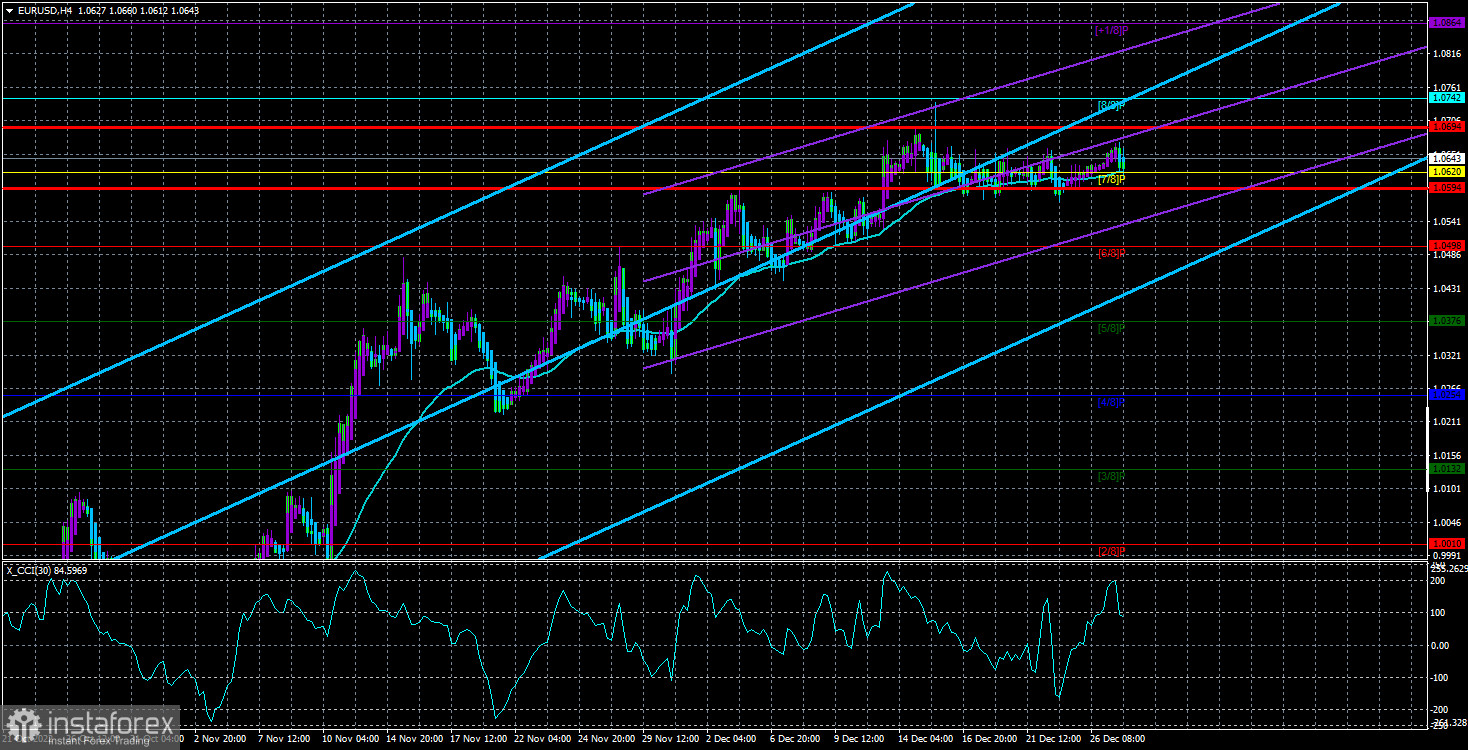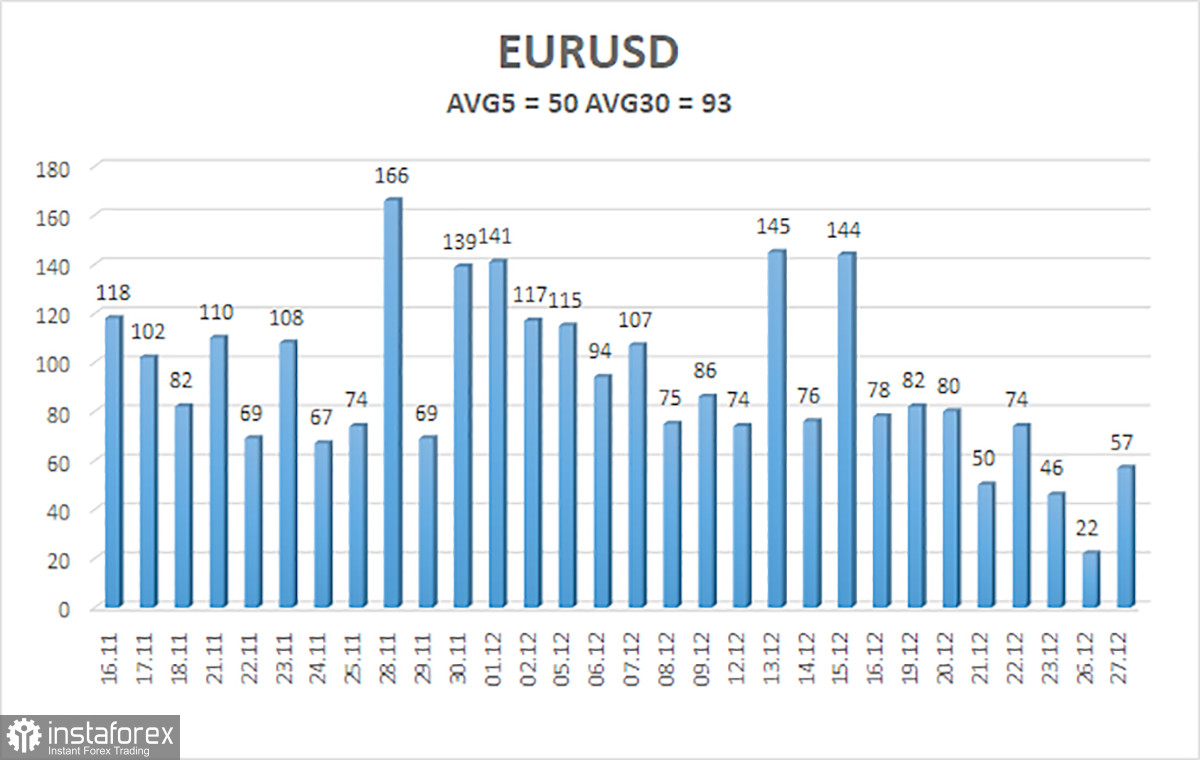
Although this fact is simple to understand, the EUR/USD currency pair was already trading with more volatility on Tuesday than it did on Monday. The reality is that the volatility on Monday was exceptionally low - only about 20 points. This value was a result of the day's actual output status. The flat was still preserved even though the indicator had already risen to average values by Tuesday, as is very clear from the above illustration. If the pair is moving in a side channel, how much volatility does it matter? As a result, there has been no change in the technical situation over the past day. However, we did issue a warning that we could observe a flat up until December 31. The pair has fallen by about 100 points from its recent highs, but there are no signs of a correction at the moment. Remember that the British pound has been actively adjusting over the past two weeks, so the fact that the pound is falling while the euro is not surprising us more than the fact that New Year's Eve will be flat.
This is not crucial at this time, though. Since there aren't any significant events scheduled for this week, traders are vacating the market. As a result, the euro/dollar pair is currently trading more sensibly. Since there is no way to plan these movements on the 4-hour TF, we can only wait for the flat to be finished. You could try trading only on the newest TF, but even then it would be very difficult and dangerous.
After the New Year, the dollar's demand might start to increase.
We think that the pair will eventually fall. Over the past few months, the value of the US dollar has dropped too far and too quickly. As we previously stated, market expectations for a slowdown in the Fed's monetary policy's tightening pace can be viewed as the primary cause of its decline. The dollar started to decline when these rumors first surfaced. But as we all know, the ECB also lowered the growth rate in December. Thus, it appears that the dollar's decline was unjustified and illogical. However, we have repeatedly called traders' attention to the absurdity of the euro and pound price increases. Even purely theoretical explanations weren't always available for this. Even when it was on the dollar's side, the macroeconomic and fundamental context was frequently interpreted in favor of the euro. And this is the first justification for why the US dollar should start to appreciate.
China is the second explanation. No matter what anyone says, we think the Chinese epidemic will have an impact on the country's economy. Despite Beijing's denial, there are multimillion-dollar diseases, overcrowded morgues, and overcrowded hospitals. If several hundred million people contract the disease, it will inevitably have an impact on demand, retail sales, production levels, and GDP. People simply refuse to report to work out of fear of contracting an infection or because they are already sick from one. It is even harder to imagine how all macroeconomic indicators will collapse if we are talking about 300 million people.
The Angolan economy is not the same as the Chinese economy, though. China accounts for more than one-third of global industrial production. As a result, many businesses will encounter a shortage of particular products, parts, or raw materials. 2020 will be reenacted, when the economy was rapidly contracting even without "lockdowns." As a result, if everything that news organizations are reporting about what is happening in China is accurate, a new financial crisis is imminent. And this is happening at a time when the Central Bank is actively raising rates to counteract the negative effects of the monetary stimulus that was required following the previous "coronavirus" pandemic. The world could once again be engulfed in an epidemic if COVID spreads outside of China, which is very likely given that Beijing recently removed all quarantine restrictions on entry and exit from the country. And it makes no difference that we now have the necessary medications and vaccines. They still only help the disease progress; they still do not offer protection against infection.

As of December 28, the euro/dollar currency pair's average volatility over the previous five trading days was 50 points, which is considered to be "low." So, on Wednesday, we anticipate the pair to fluctuate between 1.0594 and 1.0694 levels. The Heiken Ashi indicator's reversals are now completely irrelevant because the pair is flat.
Nearest levels of support
S1 – 1.0620
S2 – 1.0498
S3 – 1.0376
Nearest levels of resistance
R1 – 1.0742
R2 – 1.0864
R3 – 1.0986
Trading Suggestions:
Although the EUR/USD pair continues to move higher, we have been seeing a flat price for more than a week. Trading can only be done on the lower TF inside the side channel because the 4-hour TF hardly ever moves.
Explanations for the examples:
Channels for linear regression help identify the current trend. The trend is currently strong if they are both moving in the same direction.
Moving average line (settings 20.0, smoothed): This indicator identifies the current short-term trend and the trading direction.
Murray levels serve as the starting point for adjustments and movements.
Based on current volatility indicators, volatility levels (red lines) represent the likely price channel in which the pair will trade the following day.
A trend reversal in the opposite direction is imminent when the CCI indicator crosses into the overbought (above +250) or oversold (below -250) zones.
 English
English 
 Русский
Русский Bahasa Indonesia
Bahasa Indonesia Bahasa Malay
Bahasa Malay ไทย
ไทย Español
Español Deutsch
Deutsch Български
Български Français
Français Tiếng Việt
Tiếng Việt 中文
中文 বাংলা
বাংলা हिन्दी
हिन्दी Čeština
Čeština Українська
Українська Română
Română

